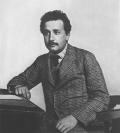 ALBERT EINSTEIN
ALBERT EINSTEIN

The fight went on and on between the Energetics and the Atomists until 1905 when a Swiss Patent Clerk by the name of Albert Einstein published a paper entitled,

Front page of Einstein's actual paper referenced as
A. Einstein, Annals de Physik, 17 549 (1905).
This may also be found translated in English in the book
Stachel, J. (1998). Einstein on Brownian motion. Einstein's Miracle Year (72-98). Boston: Princeton University Press.
Big deal you might say. The question still remains, How does this explain Brownian motion?
1. Liquid is composed of atoms
2. Atoms are in constant motion
As a result, Einstein expected that the atoms in the liquid would be constantly colliding with the suspended body. Since the atoms are totally random in the liquid, the collisions between them and the suspended body will happen at random causing the suspended body to undergo a type of random motion. This motion would be exactly like the one observed by Brown underneath the microscope in 1827 as shown in the Java Applet below5.
In this Java Applet the right hand side we see the liquid atoms (red) colliding with the suspended body (blue) causing it to move in random directions. On the left hand side we see the motion as would have been seen by Robert Brown under the microscope.
We see that by assuming that the liquid is composed of atoms that are constantly moving, we get the same qualitative results as seen by a Brownian motion experiment. But the question now becomes, Does Einstein's model explain Brownian motion quantitatively? Simply put, does Einstein's model predict exact results from a Brownian motion experiment?